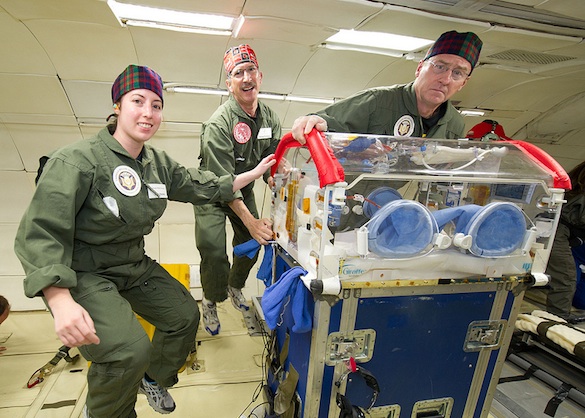Parabolic Flight Evaluation of a Hermetic Surgery System for Reduced Gravity
PI: George Pantalos, University of Louisville
PI: George Pantalos, University of Louisville

- TA06 Human Health, Life Support and Habitation Systems
The HeSS has progressed to the point in development where initial investigator-tended evaluation of design components and function in the reduced gravity environment of parabolic flight is necessary to identify strengths and weaknesses of the current design and techniques (TRL-4). Using a constrained surgical phantom with simulated blood vessels, surgical tasks to be evaluated include (1) establishing a sealed, aqueous surgical field under the constraining dome, (2) insertion, manipulation, and removal of surgical instruments, (3) control of bleeding in the surgical field, and (4) removal of debris from the surgical field. This evaluation procedure will be repeated during two additional flights with an isolated porcine heart so that control of simulated bleeding can be verified.
The findings from this initial evaluation of the HeSS will result in the necessary design modifications and revision of surgical technique needed to successfully create a HeSS prototype (TRL-7) for further validation and verification in the reduced gravity environments of parabolic and sub-orbital spaceflight. Ultimately, it is anticipated that a flight-qualified version of the HeSS will result that enables the conduct of safe and effective surgical procedures in the reduced gravity.
This experiment addresses NASA work to ensure the health and performance of crews during long-duration space exploration by contributing to healthcare options (surgery) needed for human exploration of space. This project also addresses issues of relevance to the Exploration Medical Capability element of the NASA Human Research Program. Future versions of the proposed aqueous surgery system could potentially be used with a wide variety of ground-based surgical procedures including brain and spina
The hermetic surgical system (HeSS) evaluation station proposed to be flown on the Zero-G parabolic flight aircraft is presented below. The instrumentation chassis upon which the test article will be fastened is an Anvil® Case that is covered with a transparent containment canopy with arm access ports. The developmental models of the HeSS to be evaluated are affixed to the top of the instrumentation chassis with the surgical operators positioned on each side footstrapped to the floor of the aircraft. Equipment to support the experiment are located within the instrumentation chassis with sensor cables and fluid lines passing through feed-throughs up to the Hess test article. Two video cameras will be positioned directly over the HeSS to continuously record the actions of the surgical operators and the response of the HeSS to different tasks in the reduced gravity environment.
Technology Details
-
Selection DateAFO3 (Mar 2012)
-
Program StatusCompleted
- 4 Parabolic
Development Team
-
PIGeorge Pantalos
-
Organization
-
SponsorUniversity Of Louisville
-
More Information

